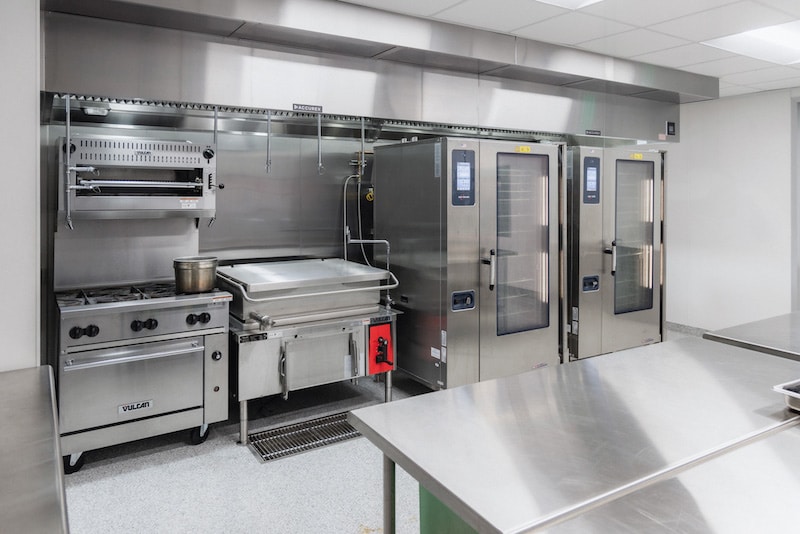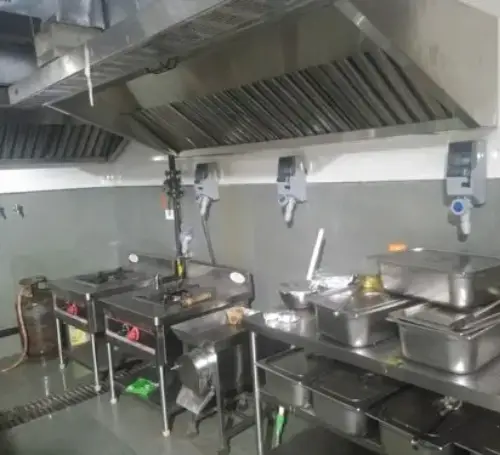As the demand for food delivery skyrockets, have you ever wondered if traditional restaurants with dining spaces are becoming a thing of the past? In cities like Kolkata, the rise of cloud kitchens—delivery-only kitchens with no dine-in option—is revolutionizing the food industry. But is this low-investment, high-reward business model the golden ticket for aspiring food entrepreneurs, or are there hidden challenges you need to consider?
If you’re curious about how to capitalize on this growing trend, you’re in the right place. In this comprehensive guide, we’ll break down the essential steps to build a profitable cloud kitchen in Kolkata. We’ll explore the specific equipment needs for cloud kitchens, offer tips on choosing the right commercial kitchen equipment, and discuss why a strategic approach is vital to turning your kitchen into a successful, scalable business. Whether you’re a beginner or looking to optimize an existing cloud kitchen, this post will provide actionable steps to help you succeed. So, Let’s dive in.
Step 1: Understanding the Cloud Kitchen Model
The cloud kitchen model, also known as a “ghost kitchen,” has revolutionized the restaurant industry. Unlike traditional restaurants, cloud kitchens don’t have a dining space. Their sole focus is on preparing food for delivery. This model significantly reduces upfront costs, making it ideal for startups or established businesses looking to expand.
Cloud kitchens typically operate from a single kitchen location but may run multiple brands or menus. They rely heavily on third-party delivery apps such as Swiggy and Zomato to get their food to customers. In Kolkata, the food delivery market is booming, which makes it an ideal city to experiment with the cloud kitchen model.
Types of Cloud Kitchens:
- Shared Kitchens: These are facilities shared by multiple food brands. While cost-effective, they may have limited space and timing slots.
- Commissary Kitchens: A large kitchen space that provides equipment and services to various businesses, allowing for a central hub for production.
- Standalone Cloud Kitchens: These are independently operated and fully controlled by the business, ideal for scalability and brand building.
Key Tip:
Choose the right type of kitchen model based on your long-term goals and budget. A shared kitchen may be perfect for startups, while a standalone cloud kitchen might better suit an established brand looking to scale.
Myth Buster:
“Think you need a prime location for a successful restaurant? Think again—cloud kitchens break that rule entirely, allowing you to focus on what matters: the food and the delivery experience.”
Step 2: Research the Food Delivery Market in Kolkata
Kolkata’s culinary landscape is as diverse as its population, with tastes ranging from street food to fine dining. When setting up a cloud kitchen, understanding what your customers want is key. Your kitchen may not have a physical presence, but it needs to stand out in the digital space. Popular food delivery platforms like Swiggy and Zomato dominate Kolkata, giving you a large potential customer base if you manage your brand presence correctly.
Market Analysis Tips:
- Check Popular Cuisines: Use delivery platforms like Swiggy and Zomato to identify trending cuisines in Kolkata. Currently, Bengali, North Indian, Chinese, and fast food dominate the delivery market.
- Study Competitors: Analyze how local competitors are positioning themselves, their menu pricing, and customer reviews.
- Evaluate Customer Preferences: Research the peak times for food delivery and average ticket sizes in different parts of Kolkata. This will help you craft a menu that appeals to the local demographic.
Reality Check:
“Kolkata’s diverse culinary landscape might make you think any cuisine will thrive, but success often comes from catering to niche markets and specific customer needs.”
Step 3: Choosing the Right Location for Your Cloud Kitchen
Location still matters in a cloud kitchen setup, though not in the traditional sense. Since your kitchen’s sole function is preparing food for delivery, its proximity to your target customer base is crucial. Fast delivery times mean better food quality and higher customer satisfaction, making delivery zones a critical factor.
When scouting locations, consider rent prices, proximity to high-demand neighborhoods, and ease of access for delivery drivers. Kolkata’s central and suburban areas offer plenty of affordable locations suitable for cloud kitchens. While you don’t need prime real estate, you do need a location that is close to your customer base.
Location Factors to Consider:
- Proximity to High-Demand Areas: Set up your kitchen close to densely populated areas with high food delivery demand, such as Salt Lake, Ballygunge, or New Town.
- Access to Delivery Drivers: Make sure the location is accessible to delivery personnel for quicker pickups and lower transportation costs.
- Affordable Rent: Cloud kitchens allow you to opt for less expensive locations outside prime areas, but ensure delivery times to key neighbourhoods remain under 30 minutes.
Pro Tip:
“Location isn’t about foot traffic to your door—it’s about access to delivery zones that ensure quick, hot food and customer satisfaction.”
Step 4: Equipping Your Cloud Kitchen for Efficiency
The right equipment is the backbone of any cloud kitchen, and choosing the right commercial kitchen equipment is crucial. Cloud kitchens typically operate in smaller spaces than traditional kitchens, so every piece of equipment must be chosen with efficiency in mind.
Essential Kitchen Equipment for Cloud Kitchens:
- High-Quality Commercial Ovens: Perfect for fast-cooking or baking multiple dishes simultaneously.
- Prep Stations & Counters: Adequate stainless steel prep areas help in keeping the space organized.
- Refrigeration Units: Keep ingredients fresh and ready for prep. Efficient refrigeration is essential for smooth operations in Kolkata’s humid climate.
- Fryers and Grills: Essential for cloud kitchens focusing on fast food or quick service items.
- Dishwashers: Automated systems to save labor and maintain hygiene.
Industry Insight:
“A smaller kitchen doesn’t mean limited possibilities. The right equipment setup can make your cloud kitchen just as efficient as any restaurant on Park Street.”
Choosing a Trusted Equipment Partner:
If you are catering to multiple brands from one kitchen, space management is crucial. Here comes PS Hospitality Services, the best kitchen equipment manufacturers that will help you select and install equipment that can handle your specific needs without taking up too much space.
Step 5: Streamlining Operations and Optimizing Delivery
Success in the cloud kitchen model isn’t just about great food—your operations need to be seamless. From efficient workflows to optimized delivery systems, you need to ensure that orders are prepared quickly and delivered hot and fresh.
Steps to Streamline Your Operations:
- Automated Order Management: Invest in a POS system that integrates with delivery platforms like Swiggy and Zomato. This ensures orders are received and processed instantly.
- Optimized Kitchen Workflow: Design the kitchen layout in a way that minimizes movement and maximizes efficiency. Staff should be able to move from one station to another without wasting time.
- Packaging for Delivery: Invest in eco-friendly, delivery-friendly packaging that maintains the quality and temperature of your food.
Takeaway:
“The fastest food isn’t always the best food—your operation needs to balance speed with quality to keep customers coming back.”
Step 6: Branding and Marketing Your Cloud Kitchen
Since cloud kitchens lack a physical storefront, your brand identity becomes even more crucial. Your customers will form opinions based on your online presence, food packaging, and reviews. Establishing a strong brand that stands out on delivery platforms is key to capturing and retaining customers.
Key Branding Strategies:
- Unique Brand Identity: Develop a brand voice and aesthetic that resonates with your target audience. Whether it’s quirky, gourmet, or homey, ensure it reflects on your menu, packaging, and digital presence.
- Professional Food Photography: High-quality images on delivery platforms can significantly increase order volume. Invest in professional photos that make your dishes look appealing.
- Leverage Social Media: Platforms like Instagram and Facebook are powerful tools for promoting your cloud kitchen. Engage with customers, promote discounts, and showcase your food.
- Online Reviews: Encourage satisfied customers to leave positive reviews on Swiggy, Zomato, and Google. This builds trust with new customers.
Insight:
“Don’t think of your cloud kitchen as faceless—your brand is just as important online as a fancy dine-in restaurant’s atmosphere.”
Step 7: Managing Costs and Scaling Up
Cost management is a crucial factor in running a successful cloud kitchen. Keep a close eye on your operational costs, including ingredients, kitchen utilities, delivery fees, and marketing spending.
Cost Management Tips:
- Food Inventory Control: Implement software to manage ingredient orders and reduce wastage.
- Scale Slowly: Start with a limited menu and gradually expand as demand increases. This allows you to test different dishes without overextending your resources.
- Partner with Multiple Platforms: Don’t rely on one delivery platform. Use Swiggy, Zomato, and others to reach a broader audience.
Pro Tip:
“You don’t need a massive menu to be profitable—cloud kitchens thrive on simplicity, scalability, and smart resource management.”
Step 8: Navigating Kolkata’s Regulations and Licenses
Setting up a cloud kitchen requires adherence to Kolkata’s local laws and regulations.
Licenses Required for Cloud Kitchens:
- FSSAI Registration: Ensure your kitchen is registered with the Food Safety and Standards Authority of India (FSSAI).
- Fire Safety Compliance: Adhere to fire safety regulations by installing necessary equipment such as fire extinguishers and smoke detectors.
- Health Permits: Maintain high hygiene standards and ensure your kitchen is inspected regularly.
Reminder:
“The paperwork might seem overwhelming, but once you’re set-up, Kolkata’s food scene is wide open for delivery-only kitchens to thrive.”
P.S. Hospitality Services: Your Go-To for Commercial Kitchen Equipment
When it comes to kitchen equipment manufacturers in Kolkata, P.S. Hospitality Services stands out as a leader in the market. With a deep understanding of the specific needs of cloud kitchens, they offer a wide range of commercial kitchen equipment that is both high-quality and cost-effective. Whether you’re looking for durable ovens, energy-efficient refrigerators, or space-saving prep tables, P.S. Hospitality Services provides solutions that cater to all your kitchen requirements.
Why P.S. Hospitality Services?
- Tailored Solutions: They offer custom kitchen designs to help you optimize space and workflow in your cloud kitchen.
- Comprehensive Solutions: From refrigeration to ovens and dishwashers, they offer a wide range of kitchen solutions.
- Quality Assurance: All equipment is built to last, ensuring that your kitchen runs smoothly without constant breakdowns.
- Expertise in Commercial Kitchens: With years of experience, they understand the challenges faced by cloud kitchens in Kolkata and offer expert advice on the best equipment for your needs.
For reliable and efficient kitchen equipment, P.S. Hospitality Services should be your go-to choice. Their customer-focused approach and commitment to excellence make them a top choice for kitchen equipment in Kolkata.
Conclusion: Building a Profitable Cloud Kitchen in Kolkata
At the beginning of the blog, we asked whether cloud kitchens are the future of Kolkata’s food scene or just a passing trend. As we’ve explored in this guide, the rise of cloud kitchens is not just a trend—it’s a sustainable and profitable business model when done right. From understanding how the cloud kitchen model differs from traditional restaurants to selecting the right commercial kitchen equipment and navigating the specific demands of Kolkata’s delivery market, this guide has walked you through the key steps to success.
By following these steps and partnering with experts like P.S. Hospitality Services, you can confidently enter the food delivery market, knowing that you have the tools and knowledge to build a successful cloud kitchen. The future of dining is shifting, and now, you have the blueprint to be a part of that change in Kolkata.





